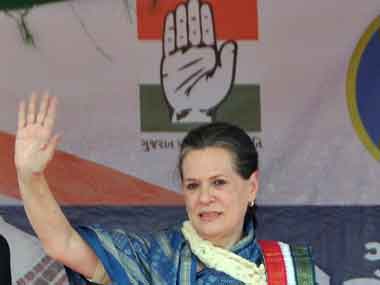A miracle - that’s what the Congress needed in Gujarat to topple Narendra Modi. But electoral politics hardly renders itself to miracles. Out of power in the state over two decades, struggling with debilitating factional rivalry, its organisation in tatters and with someone as powerful as Modi as the challenger, it had virtually resigned itself to defeat much before the campaigning gained momentum. It would have been happy to reap the minor advantage of the voter fatigue with Modi and the BJP, the rebellion of the aging war horse from the RSS stable, Keshubhai Patel, and the confusion thrown up by the delimitation process. There was never a realistic chance of it bridging the 11 percent vote share gap with the ruling party; it would have been satisfied with a few more seats than it holds at the moment. However, there’s a clear possibility that it might end up with a tally far below 59.[caption id=“attachment_563493” align=“alignleft” width=“380”]  Congress president Sonia Gandhi. AFP[/caption] According to the post-poll survey conducted by New Delhi-based the Centre for the Study of Developing Societies (CSDS), the Congress might end up with a meagre 37-45 seats and its vote share might drop by two percent to 36. The BJP is likely to be placed anywhere between 129 and 139 seats with a vote share of 48 percent, a miniscule drop of one percent in comparison to its vote share in 2007. Others, including Keshubhai’s Gujarat Parivartan Party, might end up with anywhere between 4 and 10 seats and vote share of 16 percent. The survey, conducted between 13 and 18 December in 239 polling stations areas across 60 assembly constituencies, has a sample size of 3,755. The respondents cut across a wide cross section of the population in the state. The survey was carried out at the homes of the respondents 24 hours after the voting ended. Gujarat voted in two phases - on 13 and 17 December. The results certainly have something to leave the Congress worried. Its vote share gap with the BJP, which has been gradually widening since 1995, displays no sign of narrowing down. In 1995, the vote share difference was 10 percent (BJP 43, Congress 33); it went up to 11 percent in 2002 and 2007. In this election, this is expected to go up to 12 percent. With a gap that big, the party could write itself off as a contender for power for at least two more elections. It needs something dramatic to change its fortune. In the Saurashtra region, the survey says, the Congress is set to lose three percent of its vote share from the 34 percent in 2007. This is where it was supposed to do better because of the Keshubhai factor. The BJP has lost some votes too, down four percent from 44. In North Gujarat, the party is likely to lose two percentage points from 35 and in South Gujarat the loss is likely to be around four percent (from 33). Interestingly, the others, including Keshubhai’s GPP, fare much better than the Congress in the Saurashtra region and South Gujarat. The party performs well neither in the rural areas nor in the urban pockets. In the rural areas, its vote share, as the survey reflects, is down by three percent, from 37 last year, and in the urban areas it is down one percent from 33 percent. Rural areas are where it expected to make huge gains this time capitalising on the Modi’s pro-urban policies. The message from the survey is clear. New voters don’t find the Congress a reliable alternative to the BJP. If they are unhappy with the current dispensation, they would rather vote for non-Congress players. Probably, it needs more than a dramatic turnaround. It needs a miracle.
The vote share of the party and seats are expected to dip further in Modi’s state.
Advertisement
End of Article


)
)
)
)
)
)
)
)
)



